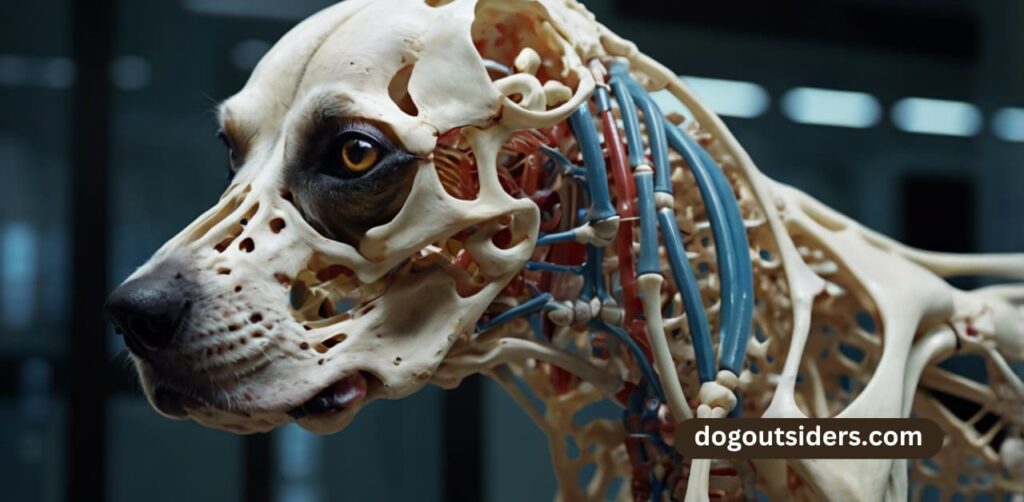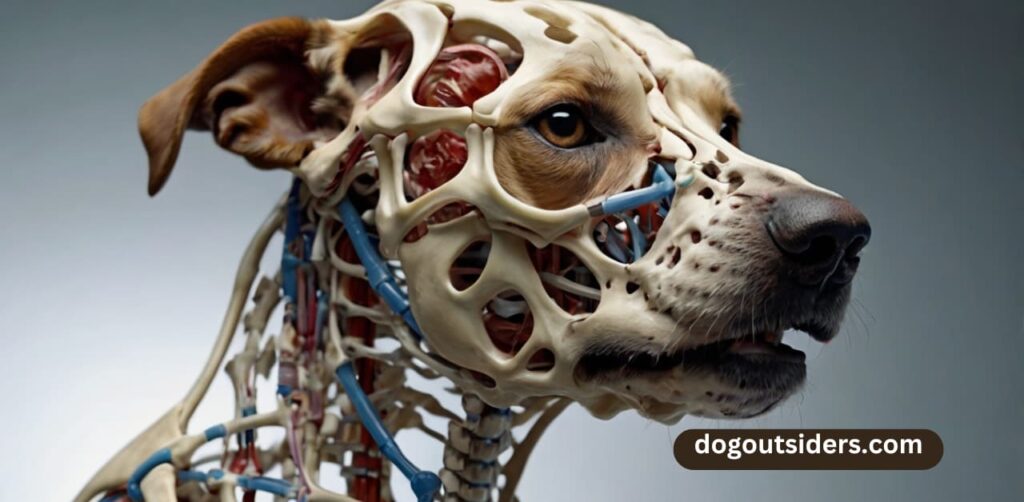Ever wonder how many bones dogs have? Amazingly, dogs have more bones than humans. Dogs pack around 320 bones, while humans have just 206. This difference affects their movement and health. Dogs have their own set of bone issues, including luxating patella, panosteitis, and osteochondrosis. These conditions mess with their daily play and cause pain. If we understand these problems, we can take better care of our furry friends. Bone health is paramount to their happiness and longevity. Monitoring their play and diet helps their bones.
Key Takeaways
- Most pups have roughly 319 bones, but the number can vary based on how long their tail is.
- It’s important to know your dog’s skeletal anatomy. This helps you identify movement and posture challenges, leading to early diagnosis of health issues.
- Puppies are actually born with cartilaginous structures that are flexible. As they age, these constructs slowly transform into bones, emphasizing the importance of proper nutrition and care during their growth.
- To support your dog’s bone health, feed him a balanced diet rich in calcium and phosphorus. Make sure to include regular exercise and take your pet for routine vet check-ups to prevent and manage any issues.
- Common bone disorders include hip dysplasia, arthritis, and fractures. If not managed and treated, these problems can heavily impact quality of life.
- Your dog’s bone health is important to understand. This insight allows you to ensure they have a happier, healthier life.
How Many Bones Do Dogs Have
If you’re a dog lover, you’ve probably wondered how many bones are in your furry friend’s body. Dogs have about 321 bones, give or take. The number varies by breed and size, but most dogs fall within this range.

Some breeds do have dew claws — those little “extra” toes higher up on the leg. These claws add to their overall bone count.
Then there’s the question of tails! The number of tail bones can range from 6 to 23, which also contributes to the total number of bones. Some breeds, for instance, the English Bulldog or the Manx cat, may have absolutely no tails.
On the other hand, breeds such as Labradors have longer tails, which contain more bones. However, it’s not purely about numbers—these bones perform important health and movement functions.
1. Total Number of Bones
The average dog has something like 321 bones. This number isn’t set in stone, as it can vary among different breeds. Thanks to genetic quirks, some breeds may have a couple more or a couple less than the average.
Dew claws, for example, can seem trivial, but they actually contribute to the total number of bones. Additionally, tails can add a surprising number of bones, depending on the breed.
Here’s a quick look:
| Factor | Impact on Bone Count |
| Dew Claws | Adds to total |
| Tail Length | Varies by breed |
| Genetic Traits | Increases or decreases |
Breeds with longer tails, like the Labrador Retriever, have more bones in their tails. This anatomical feature contributes to their overall structure and movement.
In contrast, Dobermans typically have docked tails, resulting in fewer bones. This difference highlights the variety in tail anatomy among different dog breeds.
Understanding these details allows us to appreciate how each dog’s anatomy is unique. It also helps us see how that anatomy relates to the dog as a whole in terms of its bones and overall functionality.
2. Dog Bones Compared to Humans
When you do the math, you’ll find that compared to humans, dogs have more bones. They have about 319 to 321 bones; we have 206. Where does the discrepancy come from?
Well, it’s function, really. Dogs are built for different tasks, like running, jumping, and, for some, hunting. Their skeletons support these activities, while our bones support upright walking.
Dogs and humans have similar types of bones—like ribs, skulls, and limbs—but they actually function differently. Understanding these differences enables us to better care for our doggy friends. This knowledge ensures they move comfortably and lead healthy lives.
3. Functions of the Canine Skeleton
It serves as a frame for the dog, a canine skeleton. It’s so critical people would die without it, and movement would be impossible. Bones are anchors for muscles, allowing dogs to run, jump, and play.
The tail, for example, helps in balancing and is a means of communicating with other dogs. Did you know bones are involved in blood cell production? Correct! Bone marrow, within the bones, is essential for creating blood cells.
This means bones aren’t just structural; they play a role in keeping dogs healthy from the inside out.
How Many Bones Do Dogs Have Overview
Once we know a little bit about a dog’s skeletal anatomy, we can figure out just how our playful pups get it done. It’s like a jigsaw puzzle that paints a picture of the life they lead. Dogs have approximately 319 bones in their skeletons.

These fascinating creatures have complex bone structures that can differ slightly depending on their breed and size. The canine skeleton is divided into three main parts: axial, appendicular, and visceral, each with its own unique role in a dog’s body.
These bones are important for shaping the dog. They also play essential roles in movement, blood cell production, and mineral storage. Each section plays a vital role in a dog’s health and function.
By learning this more completely, we can really improve how we care for and train dogs.
Head and Neck Structure
In dogs, the head and neck are the control center, containing the brain and all important sensory organs. The dog’s skull is made up of dozens of small bones that fit together like jigsaw puzzle pieces. This skeletal system protects the brain and allows a wide range of facial expressions.
The cervical vertebrae make up the bones in the neck. They offer adjustability and help support the head. These vertebrae allow dogs to nod, tilt, and swivel their heads. This agility makes them great at noticing a squirrel or looking at you with those puppy-dog eyes.
The jaw structure is essential to a dog’s day-to-day existence. It affects how they eat and interact with their environment. Additionally, the jaw structure influences their barking and howling, which can vary widely by breed.
Limb and Paw Composition
As far as movement goes, the limbs and paws of a dog are the main characters here. Dogs have highly developed and powerful forelimbs and hind limbs. Their long bones, including the humerus and femur, give them the ability to run fast and jump high.
The paws, with a unique structure, give dogs balance and grip. Various breeds possess distinct limb structures that are uniquely suited to their respective roles. For instance, a Greyhound has long, aerodynamic legs for running, while a Bulldog has powerful, stocky legs for bulldogging.
Joints are the facilitators of your dog’s movement. They are like hinges, allowing your pet the flexibility to chase a ball or jump into your lap.
Spine and Ribcage Details
The spine is the backbone, literally, of a dog’s body. It is composed of a column of vertebrae that plays a vital role in support. These vertebrae also encase the spinal cord, similar to a suit of armor. This structure provides dogs with their posture and their ability to bend and stretch.
The ribcage creates a protective cage around the heart and lungs. It protects these vital organs and allows the chest to expand and contract as the dog breathes. Keeping a dog’s spine healthy is paramount to their mobility and overall quality of life.
Spinal issues in dogs can also cause a range of problems. These can range from difficulty walking to persistent pain.
Interestingly, rib structures can vary between breeds, affecting their shape and breathing style.
Tail Bone Count
A dog’s tail is made up of caudal vertebrae. These usually range from 20 to 23 vertebrae, but can vary widely by breed. For example, your Labrador has a long, strong tail that’s perfect for wagging, while a Bulldog has a shorter tail.
The tail isn’t just for show; it’s a big part of how dogs communicate and balance. You may also observe your dog using its tail to express various emotions such as joy, fear, or even discomfort.
However, tails can be prone to injuries if they’re slapped around a little too much or trapped in something. Therefore, monitoring your dog’s tail health is a minor but essential aspect of caring for your pet.
Development of Dog Bones
By knowing how dog bones grow, we can provide our furry friends with the best care possible. From the time they’re frisky little puppies until they’re full-grown adults, their bones undergo significant changes. To recap, these are the stages we’ll dig into to ensure our dogs grow strong and healthy.

Growth and Maturation Stages
When dogs are puppies, their bones are little sponges, soaking up everything they need to grow. These early days are vital because this is when their bones are most pliable and prepared to stretch.
Puppies also have these special areas in their bones called growth plates. These plates are like nature’s little construction sites. They harden and work to help bones grow longer and stronger as the puppy develops.
Dogs need a certain kind of exercise to keep those bones healthy. A good balance of play and rest is what’s really vital.
Too much exercise can stress those growth plates, but just the right amount can strengthen them. That’s one reason why it’s so critical to have a vet perform check-ups during these stages.
Vets can monitor these bones as they continue to grow and ensure things are progressing normally.
Timeline of Bone Development
As our pups grow, there are certain milestones to keep an eye out for. Most dogs will grow significantly by the time they’re six months old. However, growth patterns may differ between breeds.
Some large breeds, like Great Danes, may grow until they’re around 18 months old. In contrast, small breeds typically reach full size by 9 months. Knowing these timelines helps you navigate the best diet and exercise plan for your pooch.
Here’s a quick look at some typical growth stages:
| Age Range | Growth Stage | Key Focus |
| 0-3 months | Initial Growth | Nutrition & Rest |
| 4-6 months | Rapid Growth | Balanced Exercise |
| 7-12 months | Slowing Growth | Regular Vet Check |
| 1-2 years | Maturation & Finalizing Size | Diet Adjustment |
It’s also worth knowing if you have any hereditary conditions that may impact bone growth. Certain breeds, such as bulldogs and dachshunds, are susceptible to issues such as abnormal bone growth, which causes lameness.
Monitoring your dog’s growth will nip problems in the bud and save you larger headaches in the future. Early intervention is key, particularly for those breeds that are more likely to develop bone issues.
Understanding how genetics and nutrition come into play can be a game-changer. A healthy diet is a cornerstone of strong bones, offering the raw ingredients for healthy development.
Often, more than one gene can influence bone health, and they can interact with environmental factors. For example, disorders such as osteochondrodysplasia do not allow bones to grow to their expected proportions and size, particularly in some breeds.
Bone Health in Dogs
Caring for your dog’s bones is important to keep them happy and healthy. A dog has approximately 320 bones, though this number varies slightly depending on its breed and size.
These bones provide much-needed support for your pup to run, jump, and play. Like us, dogs need a little help to keep their bones strong and in good shape.
One way to do this is to make sure that they eat the right foods and get enough exercise. It’s like giving them the building blocks for strong bones. Regular check-ups with the vet are critical as well.
Veterinarians can also catch any bone problems early, which is really nice. Look for signs of bone issues, like limping or stiffness. The more alert you are, the better you can take care of your pooch!
Supporting Healthy Bone Growth
There are some important nutrients that help your dog grow strong bones. Things like calcium and Vitamin K2 play a big part in bone building.
Calcium should comprise approximately 1.0 to 1.8 percent of their food’s dry weight. This mineral is essential for maintaining bone density and overall skeletal health.
Don’t overlook manganese, which supports metabolism and energy. Manganese works particularly well in conjunction with coenzyme Q10, enhancing your dog’s overall vitality.
Keeping your dog at a healthy weight is a good move so that you don’t put unnecessary stress on their bones. Maintaining an appropriate weight helps prevent joint issues and other health problems that can arise from excess weight.
Regular exercise, such as playing fetch or going on walks, strengthens bones and muscle. Engaging in physical activities not only promotes a healthy weight but also enhances overall fitness and well-being.
Sometimes, supplements like lactoferrin can help. These supplements do wonders in terms of stimulating bone formation and supporting your dog’s skeletal health.
Nutrition and Exercise Tips
Here are some tips to make sure your dog’s diet is supporting its bone health:
First, ensure that your dog is receiving a balanced diet that includes essential nutrients. Key nutrients for bone health include calcium and phosphorus, which are vital for maintaining strong bones. Look for dog foods that are specifically formulated to provide these nutrients in the right ratios.
Next, consider incorporating sources of omega-3 fatty acids into your dog’s diet. These fatty acids can help reduce inflammation and promote overall joint and bone health. Fish oil or flaxseed oil are excellent options to add to their meals.
Additionally, monitor your dog’s weight to prevent excessive strain on their bones and joints. Obesity can lead to various health issues, including joint problems. Maintaining a healthy weight through proper diet and regular exercise is crucial for your dog’s bone health.
Lastly, consult with your veterinarian about any specific dietary needs your dog may have. They can provide personalized recommendations based on your dog’s age, breed, and health status. Regular check-ups can also help catch any potential issues early on.
- Offer a mix of proteins, vitamins, and minerals. Jaspreet said foods that are high in manganese and vitamin C can also help reduce symptoms of arthritis.
- Activities like walking or climbing stairs build stronger bones.
- Stay Hydrated: Water keeps everything, including bones, working well.
- For a diet plan tailored to your dog’s needs.
Common Bone Disorders in Dogs
For a dog owner, it is crucial to understand the common bone disorders that can affect our beloved pets. These disorders can have serious consequences, impacting their mobility and overall quality of life.
It’s important to catch and treat these issues early, as bone-related problems can become more serious if they progress. Some breeds are prone to certain disorders, which means we have to be especially vigilant about our dog’s bone health.
Luxating Patella Description
Well, let’s talk about the luxating patella. This condition causes the kneecap to slip out of place, disrupting a dog’s smooth movement. It’s similar to when you experience instability in your own knee, making it feel wobbly.
Dogs with this condition often exhibit signs such as limping or unusual walking patterns, including skipping or hopping. It’s important to notice these signs early because they require a proper vet examination to be diagnosed.
Treatment for luxating patella varies based on severity. Options range from physical therapy to surgery. While surgery can sound scary, it can significantly improve mobility.
With some good rehabilitation, dogs can return to being playful in no time!
Understanding Panosteitis
Panosteitis is another condition you may see, particularly if your pup is a young, large-breed dog. It’s a painful inflammation that affects the long bones in their legs. Imagine your dog suddenly hesitating to move.
If they seem to be in pain when you touch them, it might be a sign of panosteitis. The good news is that this condition often resolves on its own as the dog matures. That still doesn’t make it easy to see them suffer in discomfort.
You can manage their pain with vet-prescribed medication and make sure they get rest. Plus, that extra comfort during flare-ups will help keep their spirits high.
Insights on Osteochondrosis
Next on deck is osteochondrosis, a disease impacting joint health. This occurs when cartilage does not convert to bone as it should. As a result, people experience joint pain and stiffness.
This condition can be caused by a combination of factors, such as genetics and rapid growth in young dogs. If a joint is swollen or your horse is lame, it’s time to visit the vet.
Treatment options can range from weight management to surgical intervention. These approaches are aimed at alleviating symptoms and preventing further joint damage.
Here’s a quick overview of these bone disorders and the breeds most affected.
Bone disorders can vary significantly in their causes, symptoms, and treatments. Some common bone disorders include osteogenesis imperfecta, hip dysplasia, and osteosarcoma. Each of these conditions can lead to serious health issues if not addressed promptly.
Osteogenesis imperfecta, often referred to as “brittle bone disease,” is a genetic disorder that results in fragile bones. Breeds such as the Chihuahua and the Dachshund are particularly susceptible to this condition. It is essential for owners of these breeds to be aware of the signs and symptoms, which can include frequent fractures and bone deformities.
Hip dysplasia is another prevalent bone disorder, especially in larger breeds. This condition occurs when the hip joint does not fit properly into the hip socket, leading to arthritis and pain. Breeds like the German Shepherd, Labrador Retriever, and Golden Retriever are commonly affected. Regular veterinary check-ups can help in early detection and management of hip dysplasia.
Osteosarcoma is a type of bone cancer that primarily affects larger breeds and can be aggressive. Breeds such as the Great Dane, Rottweiler, and St. Bernard are at higher risk. Early diagnosis and treatment are crucial for improving outcomes in dogs diagnosed with this condition.
Understanding these bone disorders and their breed predispositions can help pet owners take proactive measures. Regular veterinary care, a healthy diet, and appropriate exercise can contribute to better bone health in dogs.
| Disorder | Common Symptoms | Affected Breeds |
| Luxating Patella | Limping, abnormal gait | Small breeds like Poodles |
| Panosteitis | Pain, reluctance to move | Large breeds like German Shepherds |
| Osteochondrosis | Joint pain, swelling | Fast-growing breeds like Labradors |
Conclusion
You’ve got it, yes. Dogs have a lot of bones, more than we humans do. They’re delivered with approximately 319 bones, more or less. Each bone counts for movement, protection, and fun stuff like retrieving. Taking care of them? Super important. Feed your dog correctly. Exercise them often. Regular vet check-ups are a must. Immediately look for any signs of limping or unusual movement. This may be an indicator of bone issues. Keeping a dog’s bones well taken care of leaves them happy and healthy. Want to learn more about it? Explore our resources. Get to the bone of dog bone care. Let’s keep those tails wagging and our bones strong!
Frequently Asked Questions
Dogs have about 319 bones; that’s the average. This number may vary slightly depending on the breed and tail length. Recognizing health and mobility issues requires knowledge of dog skeletal anatomy.
A dog’s skeletal system includes the skull, spine, ribs, limbs, and tail. These parts provide support for movement, protection for organs, and reserves for minerals.
Dog bones get created as they grow. Puppies have growth plates in their bones, which harden as they grow up. They also say nutrition and exercise are essential for healthy bone growth.
Make sure to offer a balanced diet that is high in calcium and phosphorus. Make sure they get regular exercise based on their breed and age. Regular vet check-ups are necessary to monitor bone health.
Common disorders are arthritis, hip dysplasia, and osteosarcoma. Early detection and treatment can give your dog a better quality of life. See your vet if you notice limping or pain.
Proper exercise strengthens bones and joints. Be careful not to let her jump or run too much (especially in puppies), as this can sometimes cause injury. Adapt activities according to your dog’s age and breed.
Knowledge of bone structure helps identify health problems sooner. It aids in understanding mobility issues, preventing injuries, and caring for your dog.






